Photograph Mounting Techniques
Mounting is the technique used to secure a
photograph to a mount or display board. There are several different methods and materials to choose from
when mounting a photograph. Selection is based on several factors such as cost, convenience, equipment
availability, and conservation.
Conservation Mounting
True conservation framing dictates that the mounted photo must be cleanly removable from the
mount board. Museums must adhere to conservation guidelines, even though all acid free materials are used in
these frames. Acids and other pollutants will eventually penetrate the frame from the air and walls and
contaminate the frame, at which time the artwork must be removed and reframed with fresh materials.
For most of us, such extreme conservation rules are unnecessary, although care should be taken
to ensure general household items such as rubber cement are not used for mounting. These items may contain
chemicals that will harm your artwork immediately. There are several inexpensive mounting products available
today that are safe for your artwork. Some products such as photo corners, mounting corners, and hinging
tapes and tissues are all safe products for mounting your artwork.
Mounting Techniques Using Photo Corners and Archival Hinging Tissue
One of the main reasons that pictures buckle after being framed is that the image, mat, and mount board all expand and
contract at different rates with changes in temperature. For this reason it is important to leave the image
as free as possible to move within the picture
frame. The two primary ways of achieving this are mounting with photo corners and
hinging tissue. A key
component of conservative framing is that the image can be completely removed from the photo frame with no
change to the image. To allow the image to freely expand and contract beneath the mat, it should only be
hinged at a couple of points along the top edge of the photograph. Larger images may require 3 points. How
conservative the hinging method is depends on the type of adhesive used in the hinge. For true conservation,
there is a special Japanese paper that is used with a water-soluble wheat or rice starch adhesive.
Picture Mounting Techniques
Hinging Photograph to Mat
One way to mount your photograph or poster is to use acid free hinging tape or tissue such as Lineco
Self Adhesive Hinging Tissue to attach the image directly to the mat. The advantage of this method is
that the image will stay centered under the picture mat opening so you do not need to hinge the mat to the
mount board. The disadvantage of this method is that is depending on the hinging product used, it may be
difficult to change the mat. Note: If you are selling your image matted but unframed, it is recommended that
you do not use this method.
An easy mounting technique: Lay your image down on a
table with the top of the image hanging off the edge of the table about 1 or 2 inches. Lay your mat on top
of the image and center it. Aply two pieces of hinging tissue or acid free tape to the photograph and mat
from the bottom as shown in photographs. Lift the mat up with the image hanging down, place the mount board
or frame backing board behind it, lay your glazing (the glass or acrylic) on top and insert into the picture
frame.
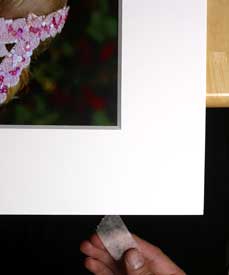

Hinging Mat to Mount Board
For the remaining image mounting techniques you will need to hinge the matboard to the mount board so the mat will stay
centered over the image on the mount board. It is recommended that you use a good acid free linen
hinging tape such as the Lineco
Self-Adhesive Hinging Tape or their Gummed
Linen Hinging Tape. The gummed version requires water activation and it is more difficult to
use. This version is recommended for more valuable art work.
Lay the mount board face up, and the mat board face down. Position them next to each
other with their tops touching. If the mount board is thicker than the mat board you will need to
place something under the mat board so it is even with the mount board. Cut a piece of linen tape
almost as long as the mat board and place it along the seam between the two boards. Now simply fold
the mat board up and over so that it is positioned right side up on top of the mount board.
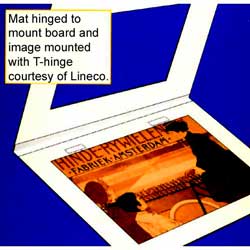
Using Photo Corners
Photo corners will provide a little more support but they generally require that the image
have a border around it on the paper it is printed on. The border allows the mat to cover up the
corners. We have a variety of different types of photo corners. 5/8
inch photo corners require a ¼ inch border. The regular 1
¼ inch photo corners require a 5/8 inch border. We also carry full
view 1 ¼ corners that have a cutout that allows them to be used on photographs with a little
over a 3/8 inch border.
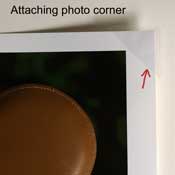

Photo corners are a great archival photo mount for picture framing since they allow you to
do your photo mounting without any chemicals coming into contact with your picture. Not all photo
corners are created equal. Make sure you do not use photo corners that contain PVC plasticizers or
acidic compounds. The two most common types of archival quality picture corners are made from polyester
film, more commonly know as Mylar (Dupont Mylar Type D) and polypropylene.
Mylar Photo Corners are the first choice of museums and provide the clearest plastic.
Polypropylene Photo Corners are not as clear as Mylar but are also inert, acid-free, safe and also
widely used for mounting. Polypropylene corners also cost about half as much as Mylar photo corners.
Plastic clarity and archival ability are more of a consideration for photo albums and
sleeves since photo corners are generally not visible in photo frames and have little contact with the
print. Mylar is reportedly good for centuries and Polypropylene is reportedly good for decades. When
storing prints under plastic care should be taken to keep the relative humidity below 80% other wise the
print can stick to the plastic. This is more of an issue with the albums since photo corners to not have
much contact with the print and typically and may only cover the white border if available.
Mylar, Polypropylene, and Polyethylene are all safe plastic materials and they are all
odorless. This is a good indication they are not out gassing harmful chemicals. If you have your prints
stored in plastic albums or sleeves that you are not certain about, a quick test is to simply smell
them. An example of a harmful plastic smell is that of a shower curtain.
An alternative to photo corners is Mylar See-Thru Mounting Strips. They are used to mount
the edges of the artwork instead of the corners.
Hinging the Image to the Mount Board
There are two types of hinges: T-hinge and V-hinge. The T-hinge is all purpose.
The V-hinge is used when you want the edges of your art to be visible and not covered by the
mat.
T-hinge: After you have hinged the mat to
the mount board (see hinging mat to mount board above), place your image under the mat and
center it. Once it is centered use some paper weights to hold the image in place. Now lift the
mat up and over so it is laying face down out of the way. You will need to place two hinges
along the top edge of the photograph. Lift the artwork up and apply a piece of hinging tissue to
the underside of the image so that is protruding past the edge of the image. It should be
adhesive side up (sticking to the bottom of the image) and should not protrude more than width
of the tissue. Place another piece on the other side. Get two more pieces of tissue and place
them adhesive side down across the top of the two pieces of tape attached to the artwork. Fold
the mat back over and you are done.
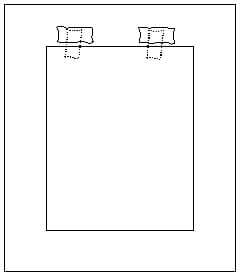
V-hinge: This method is used when you do not
want the mat to cover the edges of your artwork so that they are visible. It is very similar to the
T-hinge; however, it resides completely under the photograph. After you have hinged the mat to the
mount board (see hinging mat to mount board above), place your image under the mat and center it.
Once it is centered use some paper weights to hold the image in place. Now lift the mat up and over
so it is laying face down out of the way. You will need to place two hinges along the top portion of
the photograph. Lift the artwork up and place something under it to hold it up and out of the way.
Take two pieces of tape and place one across the other in the form of a T. Take the long side and
bend it up and over so that the adhesive is facing up. Press two of these down to the mat board
under the artwork and then press the artwork down on top of them. Fold the mat back over and you are
done.
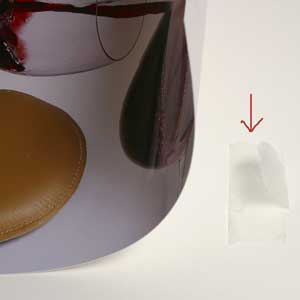
Other Picture Mounting Techniques
Dry Picture Mounting
With this technique the image is permanently attachhed to the mount board. It is often
used in cases where the image will be float mounted or left un-framed on a thick aesthetically
pleasing mount board. The dry-mounting process cannot be reversed so it is not a conservative
technique. Over time bubbles can form in the artwork depending on environmental conditions, and the
skill level of the person. It is generally not recommended for Polaroid and Inkjet prints since both
are sensitive to temperature.
Dry mounting works by placing a special adhesive tissue between the photograph and the
mount board. It is then placed in a special press that will apply pressure either mechanically or
with a vacuum to press the artwork against the mount board while applying a high temperature to
activate the adhesive in the tissue.
Dry mounting itself does not hurt the image significantly. The primary reason it
decreases the value of original artwork is that it prevents re-framing which is more of an issue for
very long periods of time. The decrease in value will be much less significant for items that are
not one of kind originals. It is not possible to prevent acid components from leaking into a picture
frame over time and contaminating the mat and mount board. For this reason museums reframe original
artwork now and then in order to completely remove those acidic compounds. If the artwork is dry
mounted, then you can not replace the mount board. Long term conservation is compromised In that
case, a museum will go through extra effort to keep the mount board from getting contaminated such
as providing an additional backing that can be replaced and by keeping the edges of the original
backing away from the edge of the photo frame.
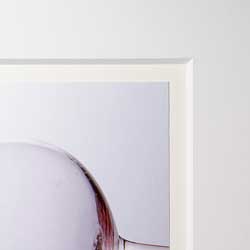
Pressure-Sensitive (Adhesive) Mounting
Crescent makes a product called Perfect Mount. This mount board is pre-coated with a
pressure sensitive adhesive. It allows you to get an effect very similar to the dry mounting technique
discussed above without special equipment and temperature damage to the photograph. The adhesive side of
the board is covered with a release paper. You remove the release paper and place the photograph on the
board. The adhesive will not start to activate until pressure is applied so you can reposition the
artwork. You will also need to make sure you remove any air from under the photograph. Once you are
happy with the position you can place the release paper over the photograph to protect it and apply
pressure using a squeegee or burnishing tool. The piece must be left alone for 24 hours while the
adhesive cures. This technique is non-archival and since the adhesive is not very span, it might not
work with thick heavy papers.
Wet Mounting
Wet mounting is similar to pressure-sensitive mounting however; you must apply wet glue or
paste to the mount board yourself. Once applied, you position your artwork on the board and then cover
it with something such as sheet of glass to apply a steady even pressure and let it dry for 4-24 hours.
This technique is non-archival and you have to be careful not get the glue on your print.
Spray Adhesive Mounting
Scotch Photo Mount
and other spray adhesives
are a little cleaner and easier alternative to wet mounting. Place your photograph upside down and spray
the adhesive on it. Be sure to overspray the sides, top, and bottom edges. Position the photograph on
the mount board and smooth it down from the center to the edges using your hand or a brayer. Typically
the spray adhesives are not as permanent as dry or wet mounting. When using spray adhesives you can
cover your work area with freezer paper to catch the over spray. Aerosol-sprays require a
well-ventilated work area and you should wear a respirator mask. Glue is not good for your lungs. Most
of these spray adhesives do not allow you to reposition your artwork, so you only get one chance to get
it right.
Additional Framing Guides
